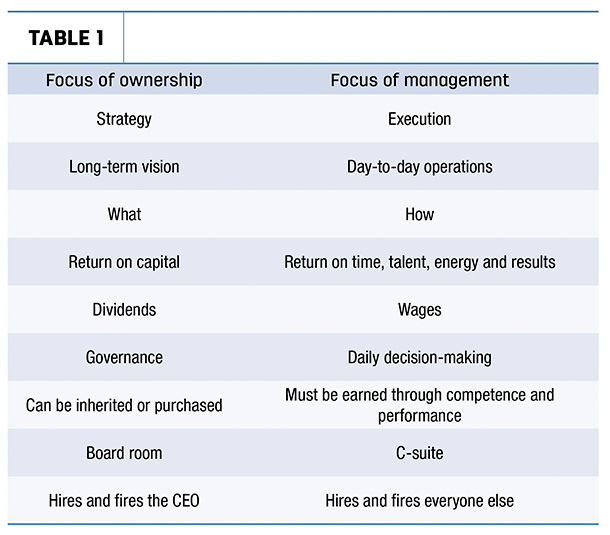There’s an old saying: “Good fences make good neighbors.” In the case of businesses, I’d modify that old nugget of wisdom slightly to say: “Good boundaries make for good businesses.”
Now, what exactly do I mean by that? Let’s elaborate.
I’ve worked with a number of businesses – both family-owned businesses and non-family partnerships – over the years and found this to ring true: The ones that were very intentional about setting clear expectations and boundaries around the separation between ownership (those who direct the long-term vision) and management (those who direct the day-to-day execution) were undoubtedly the most profitable, the least drama filled and the most efficient.
Why? In my experience, it’s because everyone in the organization, from the frontline employee to the mid-level manager to the CEO, had a very clear picture and understanding of who was responsible for what, how each individual fit into the big picture of what the organization was trying to accomplish and how they were expected to behave.
So, to understand what clear expectations regarding the separation of ownership and management look like when put into practice, it is helpful to define what those expectations entail by contrasting the rights, responsibilities and benefits between the two (Table 1).

Ownership rights
As an owner of a company, you essentially have two explicit rights. First, it is your right to define your individual return on investment expectations. It’s your money, and you determine what you expect a reasonable return to be. Second, it is your right as a provider of capital to the business to decide whether or not to continue to invest that capital in the business. To put it more bluntly, do you continue to own the business (or your shares in the business) or sell the business (or your shares in the business)? Pretty simple really; stay in or get out.
Ownership responsibilities
If, as an owner, you choose to “stay in,” your responsibilities may vary depending upon the size, complexity and formality of the ownership/governance structure. If the company is structured as a sole proprietorship, or if you are actively involved in a business with formal board governance procedures in place (i.e., a board member), you as an owner are expected to be involved in:
- Defining the vision, values and long-term direction of the company
- Hiring and firing the top management positions within the organization, including the chief executive officer, president, general manager, etc.
- Setting strategy around capital allocation, lines of business, asset sales/purchases and resources that will be provided to management in pursuit of the defined strategy
- Setting company policy around employment, compensation, dividends and capital purchases
Ownership benefits
As an owner, the only explicit benefit a company should provide to you is a return on the capital you invested in the business. That’s it, and that’s all. A tank of gas here and a trip to the Bahamas paid for by the business there – all that’s going to do is sow seeds of doubt and discontent, so avoid it at all costs. That said, in larger companies with formal board governance procedures, owners who are selected to serve as board members are often provided monetary compensation for their time, talent and energy in service of the company in the form of a daily or monthly stipend. This is reasonable and fair as long as it’s provided “above board” and commensurate with an individual’s contribution to governance.
On the other hand, management rights, responsibilities and benefits are defined as the following:
Management rights
Your individual rights as a member of the management team within a business are fairly simple:
1. Establish your individual career and compensation expectations.
2. Decide whether or not your continued investment of time, talent and energy into the business are in alignment with your personal expectations for career and compensation. If so, stay. If not, you might want to consider an alternative career path.
Management responsibilities
As a member of the management team within a business, your number-one priority is people. Your most important management role is to hire the right people, give direction to the right people, develop the right people, reward the right people, promote the right people and, if necessary, repurpose the wrong people. As a member of management, it is your understanding and use of the business vision and values that determines who the right people are. Again, ownership defines the vision, values and long-term direction of the company; management uses that vision, those values and that long-term direction as the selection criteria for people. Once the right people are on the team, it is then management’s job to direct the use of resources – both people and otherwise – in pursuit of the strategy that was defined by ownership. It is management’s responsibility to execute the day-to-day management of the company in accordance with company policy, which again was determined by the ownership. Ownership sets direction. Management then invests their time, talent and energy – in combination with the corporate resources provided by ownership – to execute strategy within the boundaries that have been predefined by ownership. Ownership determines the ends; management determines the means.
Management benefits
Whereas owners are compensated according to the amount of capital invested in the business and the relative success of the business, management should be compensated at a level commensurate for the exchange of time, talent, energy and results achieved. Management compensation is almost always provided in the form of an annual salary, bonuses tied to the achievement of company goals, benefits and other perquisites. When it comes to management compensation, an employee’s ownership status should have zero bearing on the level of management reward. In healthy companies, the degree of leadership experience, technical aptitude, level of responsibility and the ability to lead teams toward the achievement of desired outcomes should always drive the level of management compensation. No exceptions.
In summary, if you’re engaged as both an owner within a business and a manager within a business, do not, I repeat, do not mix those two distinct conversations. Be mindful during ownership conversations to limit the topics to ownership topics. When having a management conversation, again be mindful to limit the topics to management topics. Don’t mix conversations, and be as explicit as you possibly can regarding an individual’s rights, responsibilities and benefits as it pertains to the role of owner versus the role of manager.
In my experience, where most businesses create unnecessary drama, noise, conflict, bickering and infighting is when members of ownership overstep their boundaries and start meddling in management decisions or when members of management overstep their boundaries and start making ownership-level decisions.







